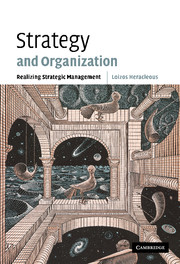Book contents
- Frontmatter
- Contents
- List of figures
- List of tables
- Preface
- I Bases of strategic management
- II Realizing strategy
- 5 The complexities of strategy implementation
- 6 Organizational culture and strategic change processes
- 7 The role of organizational discourse in understanding and managing strategic change
- 8 Strategic change processes: an organization development approach
- III Current themes and applications
- Index of names
- Index of subjects
- References
7 - The role of organizational discourse in understanding and managing strategic change
Published online by Cambridge University Press: 11 May 2010
- Frontmatter
- Contents
- List of figures
- List of tables
- Preface
- I Bases of strategic management
- II Realizing strategy
- 5 The complexities of strategy implementation
- 6 Organizational culture and strategic change processes
- 7 The role of organizational discourse in understanding and managing strategic change
- 8 Strategic change processes: an organization development approach
- III Current themes and applications
- Index of names
- Index of subjects
- References
Summary
Continuing chapter 6's focus on the ideational aspects of the organization and a change perspective, this chapter emphasizes that effective change management is not just about the “hard” structural aspects of organizations; it requires an in-depth appreciation of the cultural, human aspects of organizations, and taking actions based on this understanding. The chapter suggests that organizational discourse can provide access to this conceptual world of organizations and can also be used as an avenue for influencing it. Use of metaphor by change agents is discussed as a prime example of how discourse can help to achieve effective organizational change.
How can change be effectively managed?
Organizations are characterized by both stability and change. While forces such as inertia, uncertainty reduction, minimization of transaction costs, and the nurturing of social capital foster stability, other forces such as the need to adapt to the environment, to control costs, to gain or sustain competitive advantage, and to satisfy impatient capital markets demand continuous change (Leana and Barry 2000).
Even though some organizations are adept at managing change, sustained competitive success for most is fleeting. A study by McKinsey Consultants, for example, found that over a ten-year period, only three out of 208 firms managed to sustain their superior profitability and rate of growth (Ghemawat 2000: 20). This difficulty in sustaining a firm's competitive advantage over the longer term has been termed the “Red Queen” effect, after Lewis Carroll's story of Alice's Adventures in Wonderland, where the Red Queen said to Alice “here, you see, it takes all the running you can do, to keep in the same place.
- Type
- Chapter
- Information
- Strategy and OrganizationRealizing Strategic Management, pp. 112 - 124Publisher: Cambridge University PressPrint publication year: 2003



